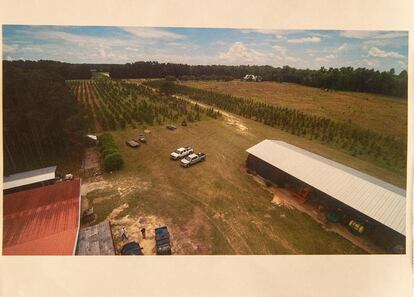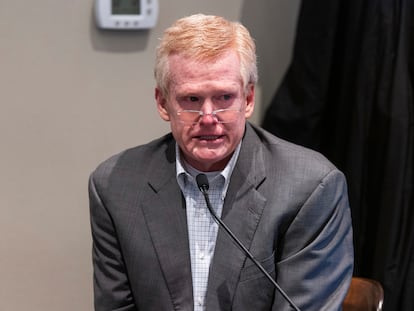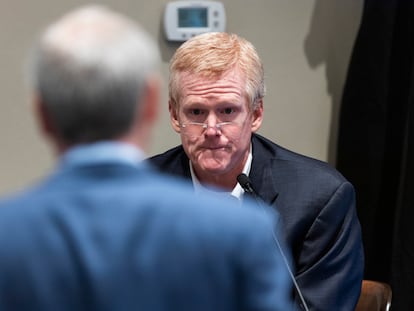Why do juries view crime scenes like the Murdaugh estate?
Crime scene visits by juries are relatively rare but have occurred in a number of other high-profile prosecutions

Jurors in Alex Murdaugh’s murder trial will get to see for themselves the rural hunting estate where his wife and son were killed, following in the footsteps of other juries that have viewed crime scenes in cases that captured the nation’s attention.
Crime scene visits by juries are relatively rare but have occurred in a number of other high-profile prosecutions, including the 1995 murder trial of O.J. Simpson and last year’s trial of Florida school shooter Nikolas Cruz.
Murdaugh, the disgraced South Carolina attorney, is accused of killing his wife and son at dog kennels near their home on June 7, 2021, as his career and finances were crumbling. Murdaugh has denied any role in the fatal shootings.
Here’s a look at the practice of having juries view crime scenes and some other notable cases:
In a criminal trial, both the defense and the prosecution can request that juries view a crime scene and it’s generally up to the judge to decide whether to approve it. In many cases, it doesn’t happen because the trial is taking place years later, so the scene has changed and taking jurors there could provide a false impression of what happened.
In some cases, however, crime scene visits can be useful to give jurors a sense of distance or other physical features that don’t come across in photos and other evidence presented in court, said Steven Benjamin, a Richmond, Virginia, defense attorney who is not involved in the Murdaugh case.
“It permits a 3D appreciation for what has otherwise been a two-dimensional presentation in court,” said Benjamin, a past president of the National Association of Criminal Defense Lawyers.
When jurors are taken to the scene of a crime, they are generally advised not to share their thoughts with one another because deliberations don’t begin until both sides are done presenting evidence. The attorneys are typically present but instructed by the judge not to say or point out anything to the jurors, Benjamin said.
“What it is not is a scene reenactment,” Benjamin said.
The distance between the kennels where the bodies were found and the home where Murdaugh says he had been napping has been a key component of the trial.
Only 16 minutes passed between when the victims stopped using their cellphones and Murdaugh left the house about 1,100 feet (335 meters) from the crime scene. Defense attorney Dick Harpootlian said the jury must see the sprawling 1,700-acre (690-hectare) property to “appreciate the spatial issues.”
Prosecutors opposed the visit because the scene has changed significantly in the 20 months since the killings. Trees planted between the Murdaugh home and the kennels have grown taller and thicker over that period — blocking the line of sight they allege would have allowed Murdaugh to see the kennel lights when he says he returned from visiting his mother.
Bill Nettles, a criminal defense lawyer and former South Carolina U.S. attorney who is not involved in the case, said the visit could give jurors a “sense of scale” to make more-informed decisions about the timeline and other questions — such as whether Murdaugh could have heard the gunshots across the grounds — that have arisen during the trial.
“I can see how both sides can benefit from a jury seeing that,” Nettles said. “In the interest of justice, it is probably a good thing for them to see it.”
Other cases
The most notable recent example was the sentencing trial for Cruz, who pleaded guilty to killing 14 students and three staff members at Parkland’s Marjory Stoneman Douglas High School.
The visit in that case was requested by prosecutors, who said jurors needed to see the scene to understand the horror of what happened. The defense vigorously objected, arguing that taking the jurors to the school would play to their emotions and that photos and videos were sufficient.
The building had been sealed off and left largely untouched — except for the removal of victims’ bodies and some personal items — before jurors visited last year and retraced the steps Cruz took on Feb. 14, 2018. Inside, they saw bullet holes in walls and shards of glass from windows shattered by gunfire. Large pools of dried blood still stained classroom floors.
Nearly three decades earlier, jurors in the Simpson trial toured the scene where prosecutors alleged that he killed his ex-wife, Nicole Brown Simpson, and her friend, Ronald Goldman. Jurors saw the spot where Nicole Brown Simpson and Goldman’s bloodied bodies were found on the walkway leading up to her Brentwood condominium.
Prosecutor Marcia Clark said at the time that taking jurors to see the narrow, confined walkway would show “the reason why one person could accomplish this, and how the victims were cornered.”
Simpson was acquitted of the killings but was later found liable for the deaths in a civil suit.
In 2003, jurors went to the North Carolina home of novelist Michael Peterson where his wife’s body was found at the bottom of a staircase. Defense attorneys argued that Kathleen Peterson had died in a 2001 accidental fall.
“They were very curious about how far up they can go up that stairwell,” said Raleigh News & Observer reporter Demorris Lee, who went with the jurors, according to a Court TV report. “Many of them went up to about the fourth, fifth step and would turn back and look, even wave their hands to see, look behind them to see if they can fall or if they can possibly catch themselves.”
That trial ended with Peterson’s conviction for murder, but a judge later ordered a new trial, and Peterson entered a special plea in 2017 acknowledging prosecutors had enough evidence to convict him of manslaughter.
Sign up for our weekly newsletter to get more English-language news coverage from EL PAÍS USA Edition
Tu suscripción se está usando en otro dispositivo
¿Quieres añadir otro usuario a tu suscripción?
Si continúas leyendo en este dispositivo, no se podrá leer en el otro.
FlechaTu suscripción se está usando en otro dispositivo y solo puedes acceder a EL PAÍS desde un dispositivo a la vez.
Si quieres compartir tu cuenta, cambia tu suscripción a la modalidad Premium, así podrás añadir otro usuario. Cada uno accederá con su propia cuenta de email, lo que os permitirá personalizar vuestra experiencia en EL PAÍS.
¿Tienes una suscripción de empresa? Accede aquí para contratar más cuentas.
En el caso de no saber quién está usando tu cuenta, te recomendamos cambiar tu contraseña aquí.
Si decides continuar compartiendo tu cuenta, este mensaje se mostrará en tu dispositivo y en el de la otra persona que está usando tu cuenta de forma indefinida, afectando a tu experiencia de lectura. Puedes consultar aquí los términos y condiciones de la suscripción digital.
More information
Archived In
Últimas noticias
Most viewed
- Reinhard Genzel, Nobel laureate in physics: ‘One-minute videos will never give you the truth’
- Pablo Escobar’s hippos: A serious environmental problem, 40 years on
- Charles Dubouloz, mountaineering star, retires at 36 with a farewell tour inspired by Walter Bonatti
- Why we lost the habit of sleeping in two segments and how that changed our sense of time
- The fall of a prolific science journal exposes the billion-dollar profits of scientific publishing










































